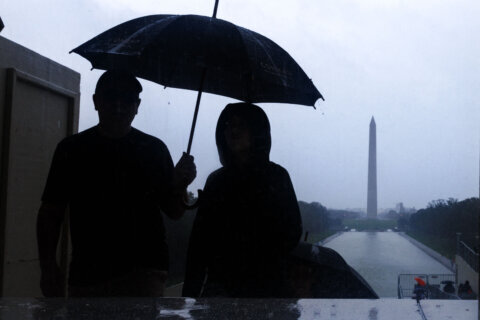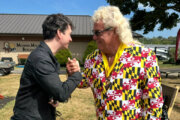WASHINGTON — The early morning hours of October 8th will provide DMV skywatchers a pretty sight – a total lunar eclipse.
We had another total lunar eclipse back in April but I was at sea so I did not see it here in the DMV (District, Maryland and Virginia area) but did witness it in the Atlantic. This eclipse will involve the Full Hunter’s Moon, or the first Full Moon after the Full Harvest Moon that took place in September. It will also present a bit of a viewing challenge as it will occur for DMV’ers low in the West and just before dawn.
The Moon will enter the outer shadow of our planet, called the penumbra, at 4:45 a.m. EDT. The penumbra is a ghostly shadow that is hard to see, but should be visible in binoculars or a telescope. Things get much easier to see when the Moon enters the dark umbra shadow of our planet at 5:15 a.m. EDT to start the partial eclipse phase. You will see the dark curvature of our planet projected onto the Moon, and as time goes on more and more of the Moon gets covered.
Things get really interesting at 6:25 a.m. EDT, as this is when the total eclipse phase begins – the Full Moon is completely immersed in the shadow of our planet. The half-way point of the eclipse occurs at 6:55 a.m. EDT. No direct sunlight is falling on the Full Moon in this phase of the eclipse, and we should see the characteristic “copper penny” color covering the Moon, but the brightening sky due to sunrise at 7:11 a.m. EDT will hinder the view.
The best place to see the eclipse is an area that has an unobstructed view of the western horizon – no trees or buildings to block the view as the Moon will be getting increasingly lower in the West as the eclipse goes on.
Get more details here and here.
Binoculars or a small telescope will help your view as you will be able to see the Moon and its colors far better than with the unaided eye. I saw the April eclipse in almost the same viewing circumstances – low in the West with the sky brightening due to impending sunrise in the East. The dimmed Moon will become more difficult to see and will set just about sunrise.
The copper reddish color that you should see is caused by sunlight passing through the Earth’s atmosphere and falling upon the Moon’s surface. If you were an astronaut on the Moon you would see the darkened Earth surrounded by a ring of light along the circumference of our planet. All of earth’s sunrises and sunsets would be visible as a reddish colored ring. It is this light that we see on the Moon during the totality phase of the eclipse.
The color and its brightness that we view on the totally eclipsed Moon can vary due to worldwide atmospheric conditions. The total lunar eclipses that occurred right after Mount Pinatubo erupted in the Philippines in 1992 were so dark as to be nearly invisible in the sky – even in my telescope. This was due to the amount of aerosols and debris from the volcano’s eruption that were placed high into the Earth’s atmosphere which blocked the passage of sunlight through our atmosphere. Scientists can measure the brightness and color of the totally eclipsed Moon to glean the condition of the Earth’s high atmosphere.
If it is cloudy and/or you want to watch the whole eclipse, you can tune in on the Internet to Griffith Observatory in Los Angeles, California which will provide a live web stream. The stream will begin at 4:15 a.m. EDT, and conclude at the end of the umbral eclipse at about 8:45 a.m. EDT.
You can take pictures of the eclipse if you have a camera and tripod. A zoom lens is a big help but almost any camera will capture the Earth’s umbra and the color of totality. You can get more information here.
The really good news is that with this total lunar eclipse, we are continuing a remarkable series of four consecutive eclipses, all visible from North America, which is called a tetrad. The next total lunar eclipse will be April 4, 2015.
Here’s to clear skies DMV!
Follow my daily blog to keep up with the latest news in astronomy and space exploration. You can email me at skyguyinva@gmail.com.
Follow @WTOP on Twitter and on the WTOP Facebook page.







